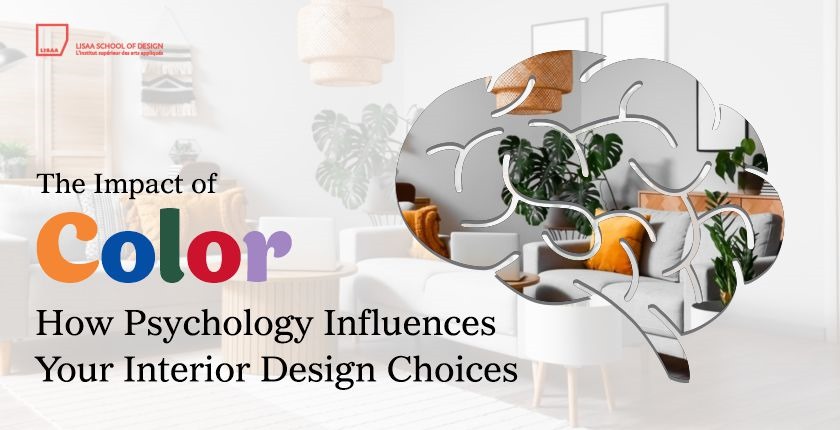Blog
The Impact of Color: How Psychology Influences Your Interior Design Choices
- January 16, 2024
- Posted by: lisaadelhi
- Category: Interior Design Blog

Do you ever wonder why certain colors instantly make us feel calm and relaxed, while others evoke energy and excitement? It’s no secret that color has a profound impact on our emotions and overall well-being. In fact, the psychology behind color is so influential that it extends far beyond fashion choices – it seeps into every aspect of our lives, including interior design. So whether you’re looking to create a serene oasis or a vibrant space full of life, join us as we dive deep into the fascinating world of color psychology and discover how it can shape your interior design choices for maximum impact.
Incorporating Neutral Colors for Balance and Sophistication
Incorporating neutral colors in interior design is a timeless and versatile approach that can elevate the overall aesthetic of any space. These hues, which include shades of white, beige, gray, and taupe, are often overlooked but have a significant impact on the mood and atmosphere of a room. By understanding the psychology behind these colors and how they influence our emotions and behaviors, we can effectively incorporate them into our interiors to achieve balance and sophistication.
Neutral colors are known for their calming and soothing effect on the mind. They create a sense of tranquility and serenity, making them an ideal choice for bedrooms or relaxation spaces. Their understated nature also allows other elements in the room to stand out without overwhelming the senses. This makes them perfect for creating a harmonious balance in any space.
One of the key advantages of using neutral colors is their versatility. These hues can be easily paired with almost any other color scheme, allowing you to experiment with different styles without compromising cohesion. For instance, pairing warm neutrals like beige or cream with cool tones such as blue or green creates a sophisticated yet inviting atmosphere. On the other hand, combining different shades of gray can add depth and dimension to a space while maintaining an elegant monochromatic look.
In addition to providing balance in terms of color schemes, incorporating neutral tones can also bring sophistication to your interior design. The simplicity and elegance of these hues exude a sense of luxury and refinement that is hard to achieve with bolder colors. Whether it’s through furniture pieces or accents like throw pillows or curtains, neutrals instantly elevate the overall aesthetic by adding a touch of sophistication.
Choosing the Right Color Scheme for Your Space
Color is a powerful tool in interior design, as it has the ability to evoke emotions, set moods, and even influence behavior. When designing a space, choosing the right color scheme is crucial in creating the desired atmosphere and achieving a cohesive look. In this section, we will discuss the factors you should consider when selecting a color scheme for your space.
Understanding Color Psychology
Before diving into color schemes, it is important to understand how different colors can affect our emotions and mindset. Each color has its own unique psychological impact that can either enhance or diminish the overall feel of a room.
– Warm colors such as reds, oranges, and yellows are known to be energizing and stimulating. They can create a sense of warmth and coziness in a room.
– Cool colors like blues, greens, and purples have a calming effect on people. They are often associated with serenity and relaxation.
– Neutrals like white, gray, and beige are versatile colors that can provide balance and sophistication to any space.
Consider the Function of the Space
The function of the room should also play a role in determining your color scheme. For instance:
– Bedrooms: Since bedrooms are meant for rest and relaxation, it is best to use soothing colors such as blues or greens.
– Living Room: This is usually considered the social hub of any home. Therefore, warm tones like yellows or reds can promote conversation while creating an inviting atmosphere.
– Home Office: To boost productivity in your workspace, opt for cool tones like greens or purples that stimulate focus and concentration.
Utilize Color Theory
Color theory refers to the principles behind color combinations based on their placement on the color wheel. Some common color schemes include:
– Monochromatic: This involves using varying shades of one single hue throughout the room.
– Analogous: This combines two or three neighboring hues on the color wheel for a harmonious look.
– Complementary: This involves pairing opposite colors on the color wheel to create a bold and vibrant contrast.
Take into Account Lighting
The lighting in your space can have a significant impact on how colors appear. Natural light, artificial light, and even the time of day can alter how we perceive colors. It is important to test out paint swatches or fabric samples in different lighting conditions before making a final decision.
Personal Preference
Last but not least, don’t forget to consider your own personal preferences when choosing a color scheme. Your home should reflect your individual style and personality, so choose colors that resonate with you.
Selecting the right color scheme for your space is not just about aesthetics but also about creating an atmosphere that aligns with its function and evokes desired emotions. By understanding color psychology, considering the function of the room, utilizing color theory, taking into account lighting, and incorporating personal preferences, you can create a beautiful and impactful interior design that truly reflects your unique style.
Applying Color Psychology in Different Rooms of Your Home
Color psychology is the study of how different colors can affect our emotions, moods, and behaviors. It has been applied in various fields such as marketing, branding, and even interior design. When it comes to decorating your home, understanding color psychology can help you create a space that not only looks aesthetically pleasing but also promotes a positive atmosphere.
Each room in your home serves a specific purpose and thus requires a different approach when it comes to choosing colors. Let’s take a look at how you can apply color psychology in different rooms of your home:
- Living Room: The living room is often the central gathering place for family and friends. To create an inviting and cozy atmosphere, warm colors like reds, oranges, and yellows are suitable choices. These shades evoke feelings of warmth and energy, making them perfect for social spaces.
- Bedroom: The bedroom is where we go to relax and recharge after a long day. Therefore, it’s important to choose calming colors like blues or greens that promote restful sleep. These cool tones have been proven to lower heart rate and blood pressure, creating a peaceful environment.
- Kitchen: The kitchen is considered the heart of the home where food is prepared and shared with loved ones. To stimulate appetite and encourage social interaction, warm hues such as reds or yellows are ideal choices for this space.
- Home Office: For those who work from home or have a designated office space in their house, productivity should be the main focus when choosing colors. Shades of blue have been shown to enhance concentration while green can improve creativity.
- Bathroom: Bathrooms are often associated with cleanliness and relaxation. Soft hues like light blues or pale greens can convey these feelings while also visually expanding small spaces.
It’s important to note that while certain colors may have general effects on people’s emotions, personal preferences should ultimately guide your decision-making process when decorating each room. For instance, if blue is known to be a calming color but you find it depressing, it’s best to avoid using it in your bedroom.
In addition to considering the purpose of each room and your personal preferences, it’s also essential to pay attention to the amount and intensity of colors used. Too much of one color can have an overwhelming effect while too many contrasting colors can create visual chaos.
Understanding color psychology can greatly impact your interior design choices and ultimately contribute to the overall atmosphere of your home. By considering the purpose of each room, personal preferences, and balance in color usage, you can create a space that not only looks beautiful but also promotes positive emotions and behaviors.
Why Choose us?
If you are looking to pursue a career in best interior design colleges in delhi offers some of the best colleges that can provide you with the necessary knowledge and skills. LIissa Delhi is definitely one of the top choices when it comes to interior design education, with its experienced faculty and industry-relevant curriculum. With these keywords – LIissa Delhi, interior design colleges in delhi, and best interior design colleges in delhi – you can easily find your way towards a successful career in this creative field. Don’t hesitate to explore your options and choose the college that suits your needs and aspirations best.
Leave a Reply Cancel reply
You must be logged in to post a comment.

